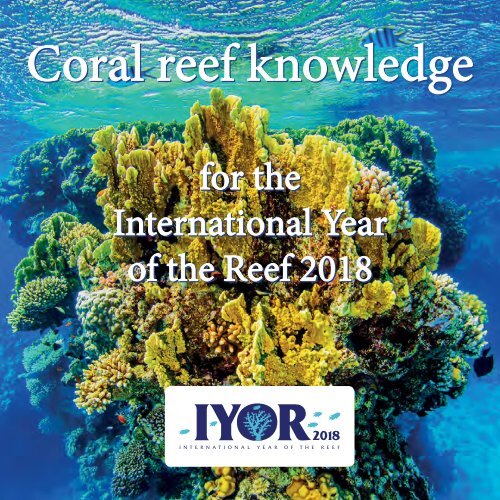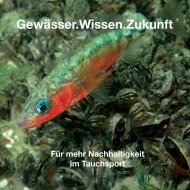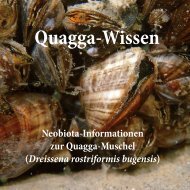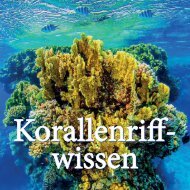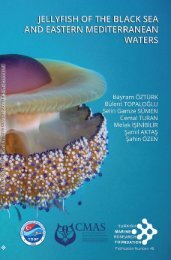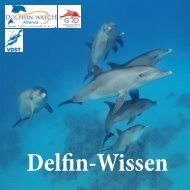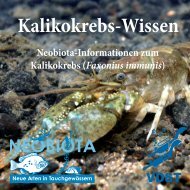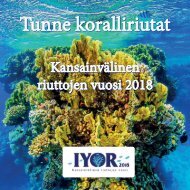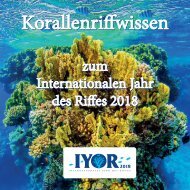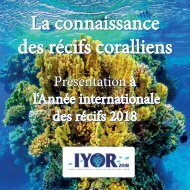IYOR 2018 CMAS E
You also want an ePaper? Increase the reach of your titles
YUMPU automatically turns print PDFs into web optimized ePapers that Google loves.
Coral reef knowledge<br />
for the<br />
International Year<br />
of the Reef <strong>2018</strong><br />
<strong>2018</strong> <strong>2018</strong>
Coral reef knowledge<br />
for the<br />
International Year<br />
of the Reef <strong>2018</strong><br />
by<br />
Franz Brümmer, Laurent Fey,<br />
Steffen Hengherr, Rachel Quick & Ralph O. Schill<br />
with photos & drawings of<br />
Herbert Bauder, Franz Brümmer, Herbert Frei,<br />
Paul Munzinger, Ralph O. Schill, Stephanie Naglschmid,<br />
Paul Selvaggio & Wolf Wichmann
Coral reefs<br />
are the most beautiful and most<br />
spectacular habitats of our planet.<br />
With an overwhelming variety of<br />
living organisms – estimated<br />
at over a million species.
The first reef-like structures<br />
are about 2 billion years old<br />
and were built from bacteria<br />
and blue-green algae.<br />
They composed of dense mats<br />
in which sediment particles<br />
become captured. A solid<br />
structure is gradually emerged.
Coral reefs, as we know them, are built from<br />
a variety of living organisms. In particular, broken<br />
and dead limestone skeletons of hard corals,<br />
shells of shells, tube worms and calcareous algae.<br />
These solidify to form the underground structure<br />
of a reef. This is very recognizable on fossil reefs.
tentacle<br />
mouth<br />
calcareous<br />
skeleton<br />
inner cell layer<br />
outer cell layer
Corals are animals which consist of two layers of cells<br />
that cover the self-produced calcareous skeleton.<br />
The nematocysts are present in the outer cell layer.<br />
The zooxanthellae are small protozoa, they live in<br />
the inner cell layer.<br />
coral cell<br />
with nucleus<br />
inner cell layer<br />
Zooxanthellae<br />
with chloroplast<br />
and nucleus<br />
outer cell layer<br />
coral cell<br />
with nucleus<br />
nematocyst
A coral reef grows only a few millimeters<br />
per year. But single stony coral species can<br />
grow very fast. Some other coral species<br />
grow up to 40 cm per year.
The fastest growing hard corals are on the top<br />
in shallow water depths, flooded with light.<br />
The massive corals like the salad corals<br />
grows very slowly.
For the hard corals<br />
itself light is not<br />
important, but for<br />
the zooxanthellae<br />
which operate<br />
photosynthesis.<br />
They produce<br />
reserve materials<br />
like sugars, of which<br />
the corals benefit.<br />
Zooxanthellae<br />
consume CO2 at the<br />
same time, this allows<br />
the corals to build<br />
a limestone skeleton<br />
and thus grow.
The zooxanthellae also benefit from<br />
this symbiosis. They receive some<br />
metabolic products from the stony<br />
corals which act as ’fertilizer’ and<br />
they are protected in the coral tissue.
If a predator approaches the<br />
stone coral, it defends itself<br />
and their zooxanthellae with<br />
nematocysts. They become<br />
ejected in a fraction of a<br />
second. This is one of the<br />
fastest movements known<br />
in the animal kingdom.<br />
There are different nematocysts.<br />
Some contain poison,<br />
others stick or wrap up<br />
attackers.
These nematocysts are also<br />
used to feed the corals.<br />
Especially at night, the small<br />
coral polyps are stretched<br />
into the water to catch food.
On interaction with the other reef builders,<br />
stony corals build large coral reefs over<br />
millennia. The Australian Great Barrier Reef<br />
is more than 2,300 kilometers long. The<br />
second largest barrier reef is after all, more<br />
than 200 km long and in front of Belize.<br />
The barrier reefs are mostly in the open sea<br />
and grown with the rising sea level.
Fringing reefs arise along a coastline and grow<br />
slowly out into the sea. They can form a lagoon<br />
with coral sand by dismantling the coral skeletons<br />
between the beach and the reef slope.
Fringing reefs are the most common reef types,<br />
especially in the Red Sea, Southeast Asia,<br />
the Indian Ocean and the Caribbean.
An atoll is the coral ring of an earlier<br />
fringing reef around a sunken island.<br />
The sinking of the island happens<br />
over millennia, so it slowly<br />
forms a lagoon in the middle.<br />
The most famous atolls are<br />
the Maldives or in<br />
the South Seas.
If hard corals are stressed, then they throw the zooxanthellae<br />
out of their tissues. This can be a reaction to warm water,<br />
strong UV radiation, pollutants in the water or diseases.<br />
As the living tissue of the stony coral largely is colorless,<br />
you can see the white calcareous skeleton which is known<br />
as coral bleaching.
But these corals are not<br />
dead yet. They continue<br />
to live using their small<br />
polyps to feed on prey.<br />
However that‘s not enough<br />
and so over time they<br />
will become weaker.
As soon as the environmental<br />
conditions<br />
improve, coral can<br />
catch and take up new<br />
Zooxanthellae from<br />
the environment back<br />
in their tissue.<br />
It’s important that<br />
zooxanthellae species<br />
are still available.
There are many different zooxanthella species.<br />
Each group has its own preferences. Some can tolerate<br />
a lot of light, others like it a bit darker, others are<br />
better adapted to warmer water. Hard corals can,<br />
depending on circumstances, push away, take up<br />
and replace zooxanthellae.
Although zooxanthellae can swim through the water<br />
themselves, they are usually transported by butterfly fish<br />
to their new homes. Butterfly fish eat coral polyps. However,<br />
not all zooxanthellae are digested. When the fish are<br />
swimming over other corals the feces fall down with<br />
the zooxanthellae and can be taken up.
When environmental conditions do not improve, algae<br />
cover corals like a dense carpet, leading to their deaths.
Algae-eating fish, such as<br />
parrotfish, or sea urchins make<br />
their way over the overgrown<br />
coral. When they are gnawing<br />
the algaes, the coral skeletons<br />
also become crushed.
Drilling shells and drilling sponges are drilling<br />
into corals. At some point the perforated coral<br />
collapses and small pieces of limestone remain.<br />
Together with mussel shells they will gradually<br />
be grated to fine white sand.
In the last few decades, the thorn crown<br />
starfish have been a great danger again<br />
and again for hard corals. In mass<br />
occurrence, thousands of animals<br />
migrate over the coral, eating<br />
the living coral tissue and<br />
leaving only the coral<br />
skeleton.
The new colonization of habitats with stony coral larvae<br />
can be quite fast, given that intact coral reefs are in the area.<br />
Nevertheless it takes decades until new coral colonies<br />
have grown up.
There are different ways<br />
to get new corals on<br />
damaged reef areas.<br />
For example, fertilized<br />
hard coral eggs and<br />
larvae can be collected<br />
by scientists.
The larvae are settled on small<br />
ceramic tiles. They grow in the<br />
aquarium and can be later<br />
distributed in the reef.
Stone corals can also become multiplied by using cuttings.<br />
These are small pieces broken off and glued on a new<br />
underground.
For the reconstruction of<br />
artificial coral reefs,<br />
different materials<br />
and forms can<br />
be used.
Today our reefs are unfortunately<br />
not only beautiful, but also severely<br />
threatened – especially by human<br />
activities. The danger has increased<br />
due to global climate change.<br />
Climate change leads to a warming<br />
of the water, to sea level rise and to<br />
an acidification of the oceans.<br />
For the hard corals, this results in<br />
difficulties to grow fast enough and<br />
build up stable calcareous skeletons.
Marine pollution and<br />
overuse of the seas are also<br />
responsible for the fact<br />
that coral reefs are today<br />
the strongest threatened<br />
ecosystems on earth.
In order to be able to experience the fascinating<br />
underwater world in the future, everyone has to<br />
take a little responsibility for it.<br />
The World Underwater Federation (<strong>CMAS</strong>)<br />
joins and supports<br />
the International Year of the Reef <strong>2018</strong>.
Your will find more<br />
information about the<br />
International Year of<br />
the Reef <strong>2018</strong> at<br />
www.iyor<strong>2018</strong>.org
© <strong>2018</strong>, envirocom, Tübingen<br />
All rights reserved. No part of this publication<br />
may be reproduced, stored in a retrieval system,<br />
or transmitted in any form or by any means,<br />
electronic, mechanical, photocopying, electronic<br />
or otherwise, without the written permission<br />
of envirocom.<br />
Picture credits: Herbert Bauder: pages 28-29, 31,<br />
46-47; Franz Brümmer: Page 6-7; Herbert Frei:<br />
front and back picture, 2, 4-5, 14-15, 22-23, 24-25,<br />
26-27; Paul Munzinger: Pages 8-9, 10-11, 12-13,<br />
18-19, 20-21, 41, 44-45; Stephanie Naglschmid:<br />
drawing page 8-9; Ralph O. Schill: page 30, 32-33,<br />
34-35, 36-37, 40; SECORE International / Paul Selvaggio:<br />
page 38, 39; Wolf Wichmann: Pages 42-43;<br />
Pixabay.com: page 16-17.<br />
Printing and binding: Printzipia<br />
®<br />
a brand of bonitasprint gmbh,<br />
Würzburg<br />
The production takes place carbon neutral.<br />
Printed in Germany.


